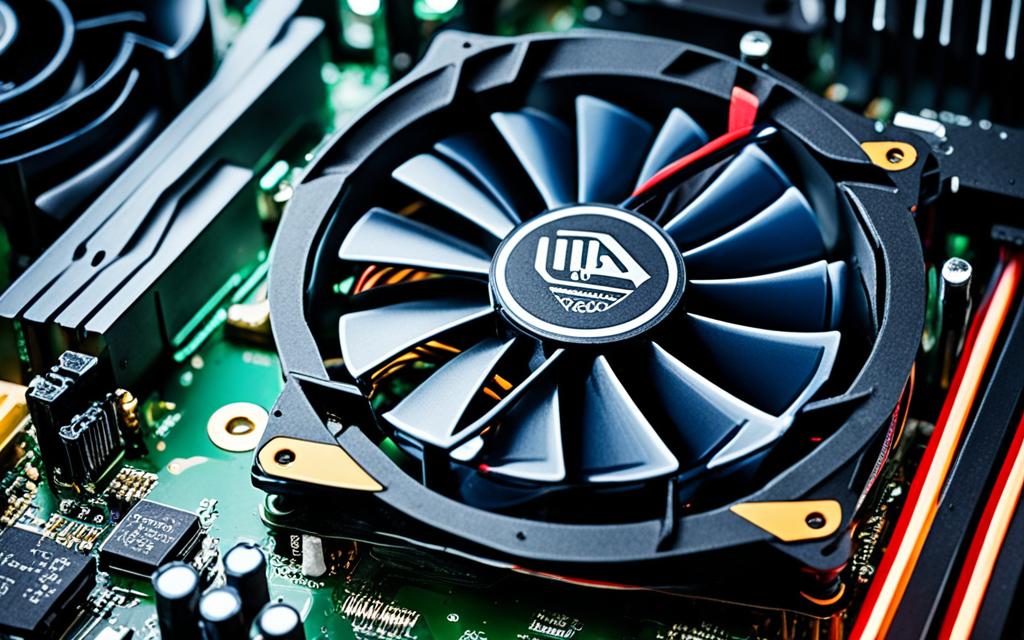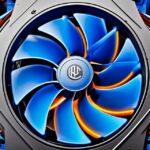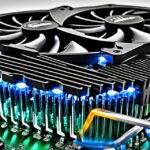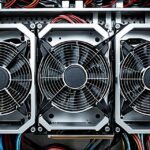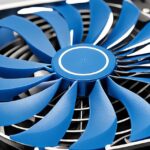Table of Contents
If you love building PCs, getting the fan direction right is key. It ensures your system runs smoothly for a long time. We’ll look at how to figure out which way your PC fans are blowing. Plus, we’ll see why the right direction matters for effective cooling.
Most case fans today have arrows showing airflow direction. This makes it easier to set them up correctly1. You can also look at the fan blades to guess the direction; if they curve towards you, that’s the exhaust side. If they curve away, that’s where air comes in1.
Key Takeaways:
- Having two intake fans to pull in cool air is key. Then, let hot air escape via the exhaust fan1.
- Knowing which way your fans are facing is important. Wrong airflow can cause your PC to overheat, slowing it down or harming parts1.
- It’s also essential to understand your PC case’s air pressure. This helps in making sure your system stays cool and works well1.
Keep an eye out for what’s next. We’ll dive into finding your PC fan direction to boost airflow in your system.
How to Determine the Direction of the PC Fan?
Figuring out your PC fan’s direction is key for top cooling. Luckily, it’s easy to find out which way the air flows.
To find your PC fan’s direction, first, look for an arrow on its casing. Turn off your PC and open the case. Search for an arrow or “in” and “out” signs to know the airflow2.
If you can’t see any signs, check the blades’ shape and how the air moves. PC fans have sides for sucking air in and blowing it out. Ensure the fan moves air as shown by the arrow or its intake side. This boosts your PC’s cooling2.
Sometimes, you won’t see any arrows or be sure of the airflow. In that case, look at the fan’s manual or search its model online. Many makers provide info and guides online to help2.
The fan near your CPU should always push air out. It stops your CPU from getting too hot. The fans in the front and back, and top and bottom, should blow the same way2.
To put a new fan in, place it in the case and line it up with the holes. Secure it with screws. Then, connect it to the motherboard2.
In short, knowing your PC fan’s direction is vital for cooling. By spotting the arrow or checking the blades and CPU fan’s direction, you ensure good airflow. If unsure, always check the manual or look online2.
Why is Fan Direction Important?
Fan direction is key for PC cooling. It ensures good airflow and efficient heat move-away. Getting the fan placement right stops overheating. This protects the PC and makes it last longer.
Knowing how fan direction works helps PC fans. They can set up their systems for better cooling. Proper fan setup keeps the CPU and GPU cool, even during tough jobs or games.
The Impact of Fan Direction on Airflow
The way a fan faces affects air movement. If it’s wrong, it messes up airflow. This can create hot spots and poor cooling.
Creating a negative air pressure inside the PC is advised. This means having more fans pulling air out than in. It helps get rid of warm air faster.
A usual PC setup has a front fan that draws air in. It’s near the hard drives for extra cooling3.
The power supply often has a fan too. It pulls air from inside and pushes it out the back3.
Most PCs have a spot for a back fan. It works with the power supply fan to push air out3.
Adding fans on the side or to the CPU heatsink can help. It depends on the PC and what fans it already has3. CPU fans typically pull air in and push it onto the heatsink. Some new designs push air across the heatsink instead3.
The CPU fan’s position is also important for air movement. It helps get the warm air out3.
Determining Fan Direction
Finding out which way a fan blows is crucial. Some fans show this with marks. Others don’t, making it trickier to figure out.
On a PC forum, 21 users shared tips for checking fan direction. They mentioned things like the blade direction and where the wires are4.
One tip is to look for arrows on the fan frame. They show spin direction and airflow path4.
You could also just plug the fan in and feel where the air goes4. Some even use smoke to see how the air moves4.
A common method is checking where the support beam on the fan is. It often shows the airflow direction4.
Following these tips and looking at the data4, users can make sure their fans work best. This leads to efficient PC cooling.
Continue reading: Is There a Visual Way to Identify if a Fan is Intake or Exhaust Mode
How Often Should the Fan be Dusted?
Dusting your PC fan is key to keeping it working well and stopping it from getting too hot5. It’s wise to clean your PC fan at least twice a year. Yet, how often depends on your surroundings and the fan type65.
If your computer stays off the ground and away from pets and smoke, cleaning every six to twelve months works6. But, if you have pets or a lot of dust, aim to clean it every two to three months6.
Case fans, CPU fans, power supply fans, and video card fans all need regular cleaning. This keeps the cooling effective6.
Recommended Cleaning Tools
Having the right tools makes cleaning better:
- A can of compressed air: It helps get rid of debris.
- Cotton swabs or cosmetic pads: Good for tiny, delicate areas.
- Isopropyl alcohol: Works on tough stains or residue.
- A microfiber cloth: For wiping off dust and dirt.
- A small screwdriver: Needed for tight spots.
With these tools, you’re set for a comprehensive clean6.
Important Safety Measures
It’s crucial to be safe before you start. Make sure to turn off and unplug your computer. This prevents electric shock6.
Also, don’t use a vacuum or hairdryer for cleaning. They can create static that harms your PC6.
Proper Handling and Precautions
Be careful not to disturb the hard drive or power supply. This might void warranties and be risky6.
Clean your PC fan often to keep cooling efficient and improve your computer’s lifespan and performance55. Stick to the suggested cleaning schedule and methods to keep your PC fan in top shape.
Correct PC Airflow Direction
To keep your PC running smoothly, it’s key to get the airflow right. This stops your system from overheating. Arranging intake and exhaust fans correctly and ensuring positive air pressure are big steps towards better cooling7.
Intake and Exhaust Fans
Intake and exhaust fans are key parts of keeping your PC cool. Intake fans pull in cool air, and exhaust fans push out warm air7. You should put intake fans at the front or bottom for cool air to come in. Exhaust fans fit best at the top or back to push hot air out7.
Positive Air Pressure
Having more air come in than go out creates positive air pressure. This keeps dust away and helps your PC stay cool. By having more intake fans, air pushes out through vents, keeping dust out and cutting down on clean-up7.
For liquid cooling, place fans to pull cool air across the radiator. This pushes warm air out. It makes sure the cooling liquid stays cool and your components don’t overheat7.
Proper Spacing and Considerations
It’s also important to space fans properly from other parts. This helps air move smoothly and cool more efficiently7.
Look at the maker’s guide when placing fans for the best results. They tell you where to put fans for good cooling. This keeps your warranty valid too.
Finding the right airflow direction can be tricky. Not all fans show which way air flows7. You might need to do simple tests like using your hand or a tissue to feel the air. Checking the blade shape helps too, air moves from the side that bulges out to the side that dips in7.
In short, getting your PC’s airflow direction right is crucial. It stops overheating by placing fans correctly, creating the right air pressure, and spacing fans well. This makes your PC run better for longer7.
How can I Make My PC Airflow Better?
To make your PC cooler and work better, follow these steps. They enhance performance and manage temperature. The steps are:
- Regular Cleaning: Dust can block airflow and keep heat trapped. Clean your PC often to remove dust from fans and other parts. This ensures good air flow and cooling8.
- Proper Fan Placement: Place intake fans at the front or bottom and exhaust fans at the top or back. This setup pulls in cool air and pushes out hot air8.
- Cable Management: Organise cables so they don’t block air. Cable ties or channels can help keep cables tidy and out of the way of airflow8.
- Temperature Monitoring: Use software to watch your PC’s temperatures. If it gets too hot, you can change fan speeds or add more cooling8.
- Implement Balanced Airflow: Use both intake and exhaust fans for steady temperatures. The right number of fans depends on your PC’s size and design8.
- Choose the Right Fans: Fans come in different sizes and styles. Decide if you need fans for airflow or static pressure. High-quality fans like Noctua NF-A12x25 are great but cost more89.
- Quieter Operation: Look for fans that cool well but make less noise. Silent operation fans keep your PC cool without being loud8.
Following these tips can make a big difference in your PC’s cooling and airflow. This means better performance, stability, and a longer life for your computer.
Popular Case Fans for Better PC Airflow
| Brand | Model | Features | Price (Approx.) |
|---|---|---|---|
| Arctic | P12 PWM 120mm fan | Pack of five, PWM control | $30 to $358 |
| Noctua | NF-A12x25 120mm fan | High performance, low noise | $358 |
| Lian Li | UNI Fan V2 SL120 fan | RGB lighting, daisy-chain connection | Prices vary |
| be quiet! | Pure Wings 2 120mm PWM high-Speed, BL081, Cooling Fan | Performance, build quality, affordability | Prices vary8 |
Here are some top case fans to boost your PC airflow and cooling. Choose based on what you need and your budget.
What Factors Should be Considered when Deciding Fan Direction?
Choosing the right way for your fans to blow is key to keeping your PC cool. Think about factors for fan direction, component orientation, cooling setup, case design, and the environment.
Component Orientation and Cooling Setup
The placement of parts like the CPU and GPU greatly affects which way your fans should face. Their location and how they get rid of heat are important. Keep these in mind when you choose where your fans should go.
If you’re using air or liquid to cool your computer, this will dictate the fan direction. Air cooling needs fans to move air, while liquid cooling uses radiators. Knowing your cooling method helps pinpoint the best direction for airflow.
Case Design and Fan Placements
Your computer’s case design and where fans can be placed are critical to consider. Every case is different, with its own way of moving air. Look at vent locations, dust filters, and cable management to ensure smooth air movement.
According to data from10, balancing your fans is vital. For example, a Lian Li D8000 case works best with 6 intake fans at the front and 3 exhaust fans at the back. This setup helps to cool your PC efficiently.
Environmental Factors
Where you keep your PC can influence how you should direct your fans. Think about the room’s temperature, how humid it is, and dust levels. These can affect your computer’s cooling. Based on data from11, even the air pressure around your case matters.
Testing and keeping an eye on how your PC runs can lead you to the best fan setup. You might need to adjust how fast your fans spin, change their number or size, or switch their direction. This ensures your PC stays cool in the best way possible.
Reference:
Conclusion
Getting PC fans to blow in the right direction is key to keep everything cool. It helps pull heat away from the CPU. This keeps your system at a good temperature12. If you put fans in wrong, your PC could get too hot. This may cause it to slow down or parts to wear out faster. That’s why it’s important to check fan setup12>.
Things like managing cables, dealing with dust, and updating thermal paste are also vital. They all help keep the air moving and your PC cool12. Also, watching your CPU’s temperature can guide you on fan speeds. This balance can make your PC run well without much noise12.
Choosing where to place PC fans wisely will ensure your computer stays cool. Make sure to clean fans and parts often to avoid any blockage12. Sticking to best practices for PC cooling adds years to your system’s life. It makes your computer more dependable12.
Want more tips on perfecting your PC’s cooling? Visit this guide for advanced advice. It’ll help you get the best out of your PC cooling system13.
FAQ
How can I determine the direction of the PC fan?
To find the PC fan’s direction, first, switch off your PC and open the case. Then, look for an arrow on the fan’s casing. This arrow shows the airflow direction. If no arrow exists, check the fan blades’ orientation or feel for airflow.
If you’re still not sure, look for the fan’s manual or search its model online. This should give you the guidance you need.
Why is fan direction important for PC cooling?
Fan direction matters a lot for cooling your PC. It helps air flow correctly through the system. If the fan’s facing the wrong way, your PC might get too hot. This can harm important parts like the CPU and GPU, possibly leading to damage or crashes.
How often should the PC fan be dusted?
You should clean your PC fan regularly, ideally every three to six months. Yet, this can change based on your environment and type of fan. Dust can block air, making your PC warmer than it should be. Power off and unplug your PC before cleaning with air dusters, brushes, or cloths.
What is the correct airflow direction for a PC?
The right airflow setup depends on your system and its parts. Usually, you’ll want to pull cool air in from the front or bottom. Then, push the warm air out from the top or back. If you’re using liquid cooling, make sure the fans help cool air cross the radiator well.
Fans should not be too close to each other or the components. This avoids air mixing up and helps cool better.
How can I enhance my PC airflow?
For better airflow, keep your PC clean and position your fans correctly. Have intake fans at the bottom or front and exhaust fans at the top or back. Organise your cables to avoid blocking air. Also, watch your PC’s temperature to make sure it’s not getting too hot.
Using both intake and exhaust fans properly will help keep your PC cool. This prevents damage and keeps your PC running smoothly.
What factors should be considered when deciding fan direction?
Choosing fan direction involves several factors. Think about how your PC parts are arranged, your cooling system (air or liquid), and where your PC’s placed. Every PC setup is unique, so you might need to try a few setups to see what’s best.
Watch how your PC performs and feels temperature-wise. This can guide you to the best airflow plan.
What is the importance of proper PC fan direction?
Getting the fan direction right is key for good cooling. It makes sure cool air comes in and warm air goes out. This keeps your PC from getting too hot, which could harm it. It’s also vital to clean your fans and check airflow often to keep everything working right.
Source Links
- https://www.cgdirector.com/pc-fan-airflow-direction/ – How to Tell Which Way Your PC’s Case & CPU Fans are Blowing
- https://www.partitionwizard.com/partitionmanager/pc-fan-direction.html – PC Fan Direction: How to Install Fans in PC – MiniTool Partition Wizard
- https://superuser.com/questions/527711/in-which-direction-should-an-extra-case-fan-be-fixed – In which direction should an extra case fan be fixed?
- https://www.overclock.net/threads/how-can-you-tell-which-way-airflow-goes-on-a-fan.231081/ – How can you tell which way airflow goes on a fan??
- https://www.howtogeek.com/how-often-should-you-dust-out-your-pc/ – You Have to Dust Out Your PC Sometime, So How Long Can You Wait?
- https://www.askteamclean.com/us/en/cleaning/how-to-clean-a-pc-fan.html – How to Clean a PC fan
- https://forums.anandtech.com/threads/how-to-tell-fan-direction.2209232/ – How to tell fan direction
- https://www.pcworld.com/article/394576/how-to-tell-which-way-your-fan-is-blowing.html – How to tell which way your fan is blowing
- https://www.techpowerup.com/forums/threads/how-to-know-the-case-fan-is-input-ouput.301978/ – How to know the case fan is input/ouput?
- https://www.overclock.net/threads/adjacent-fans-blowing-in-opposite-directions.1661873/ – Adjacent fans blowing in opposite directions?
- https://www.linkedin.com/advice/0/what-pros-cons-positive-vs-negative-pressure-pc-cases – What are the pros and cons of positive vs negative pressure in PC cases?
- https://softwareg.com.au/blogs/computer-hardware/which-way-does-cpu-fan-blow – Which Way Does CPU Fan Blow
- https://news.ycombinator.com/item?id=17170970 – Ask HN: Do I place the fan so that it blows air inwards or outwards?

